Andrea Feeser
First issued in 1787, Josiah Wedgwood’s antislavery medallion appears in several versions: black figure on a white or cream ground, white figure on a blue ground, and copper red figure on a black ground, the second color combination now synonymous with Wedgwood (Figs. 1, 2, and 3). In her recent book Melancholy Wedgwood, Iris Moon notes that the capitalist creator of the famous Wedgwood Blue was an abolitionist who wished to free the enslaved Black persons upon whom capitalism depended. For Moon, this contradiction points to melancholy (often associated with blue) as a disruptive loss that accompanies capitalism—loss of personhood in the case of the enslaved, and loss of moral consistency in the case of Wedgwood.[1] My reading of contrasting color in the different versions of the antislavery medallion also addresses loss but does so in the context of White gain in the form of cultural capital. I view the object as embodying tensions surrounding the contrasting colors that British and American makers and consumers deployed to represent White freedom and Black as well as Native subjugation.[2] I argue that the medallion’s bicolor palette was deeply implicated in racialized notions of self and other embedded in material acquisition and visual representation.
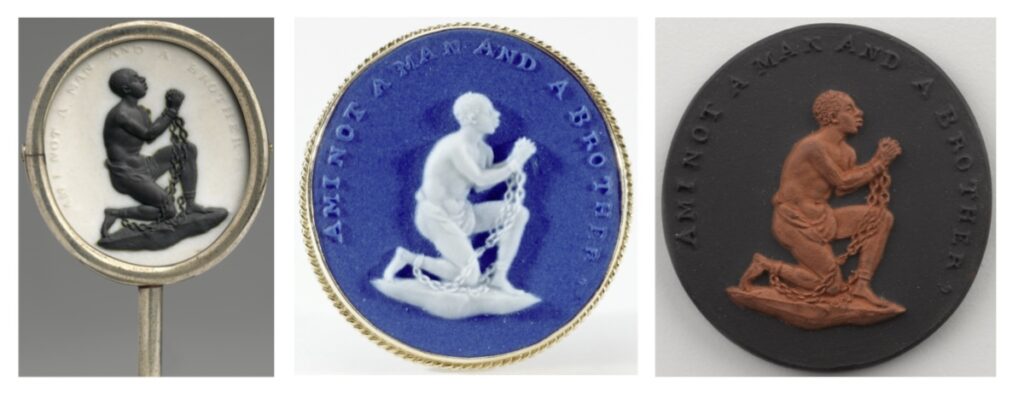
MIDDLE: Fig. 2. Henry Webber (artist), Wedgwood Factory (manufacturer), William Hackwood (modeler), Anti-Slave Trade Medallion, modeled 1787, manufactured early 19th century. Blue-and-white jasperware ceramic, 3.49 cm. overall. Virginia Museum of Fine Arts, Virginia Museum Art Purchase Fund. Image courtesy of Virginia Museum of Fine Arts.
RIGHT: Fig. 3. William Hackwood, Medallion, after 1786. Terracotta on basalt (stoneware), 3.2 x 3.2 cm. Brooklyn Museum, Gift of Emily Winthrop Miles, 55.9.25v. Image courtesy of Brooklyn Museum.
Color Contrasts, Consumption, and Standing
The desire of Britons, Europeans, and Americans to secure stature helped fuel eighteenth-century consumption.[3] Both displayed and used, products of art and design created at different price points afforded cultural capital along the social spectrum. Color operated in these conditions variously, often with fashion in mind. It was employed for verisimilitude (to reflect what was observed), symbolism (to reference values such as patriotism), and appropriation (to approximate desired foreign goods such as Chinese blue and white porcelain).[4] At the same time, with most manufactures, its use was determined by practical considerations such as cost and durability, as well as ease of production and application. Makers who used color had a full range with which to work, as pigments were stabilized through study and experimentation and enhanced by colonial products such as indigo for blue and cochineal for red.[5]
The Wedgwood medallion’s colors—red, black, white, and blue—were colors that were straightforward to source and employ, symbolically significant, and fashionable.[6] Red, black, and white resonated with Classical culture: in vessels for the former two, and in marble sculpture for the latter. Red, white, and blue were and remain the colors of the British, French, and American flags and figured in military uniforms to signal patriotism then as they do today. In part due to such associations, this palette was also highly fashionable. Britain and France produced toile fabric for upper- and middle-class consumers that featured a white ground with typically blue, red, and black printed scenes often taking the form of neoclassical allegories. Blue was the most popular color in eighteenth-century Europe and its colonies, and blue and white Chinese porcelain and Chinese-inspired ceramics were avidly collected as a demonstration of taste.[7] Europeans and Americans of means offset their variously colored attire with powdered white wigs deemed sophisticated, and women beautified themselves with whitened faces and hands, made even more pronounced with cheeks colored red. When people displayed Wedgwood antislavery medallions as part of their attire or home decoration, they participated in an aesthetic of colored contrasts that circulated beliefs about and experiences of position vis-à-vis others. These conditions of fashion and display were filtered through admiration of Classical antiquity, standing secured by class inherited or emulated, national pride in the context of growing empires, and frequently, ideas of human difference attuned to White supremacy.
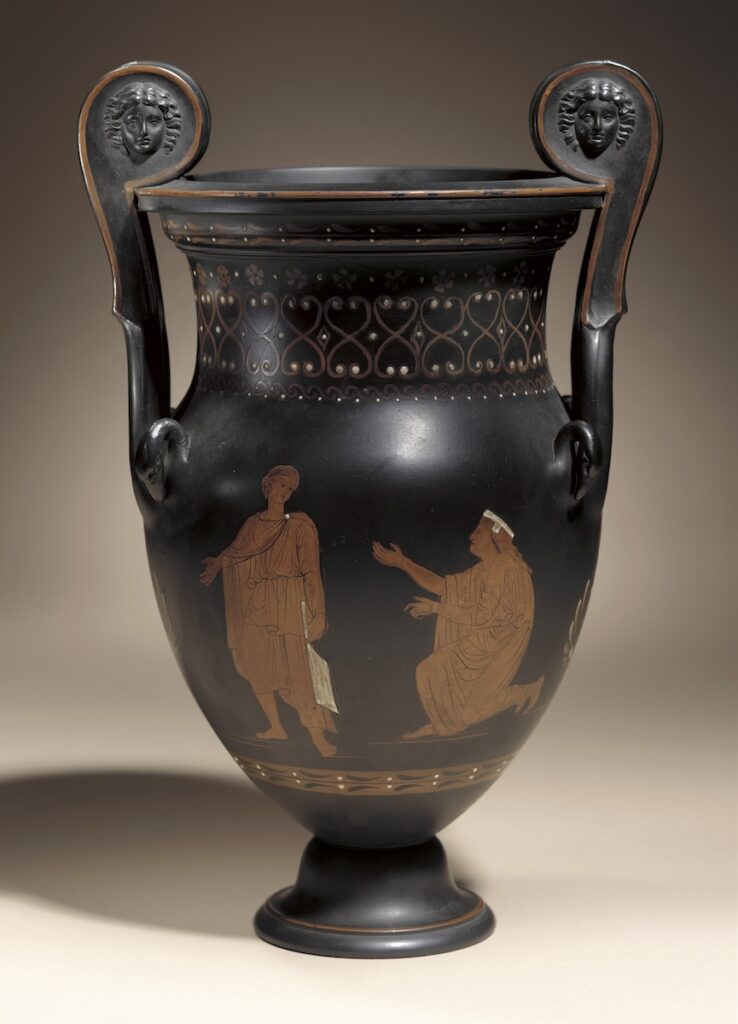
Contrasting color relationships between figure and ground was a hallmark of Wedgwood’s work, as exemplified by his single color printed or painted line drawings on creamware made famous by the Queen Charlotte and Catherine the Great commissions. Contrasting color also appears in Wedgwood’s black basalt (invented in 1767) with red painted designs; redware with black decoration (which the potter termed rosso antico from 1776); and jasper (invented in 1775) in various colors with raised white designs, often on blue grounds.[8] Wedgwood’s red on black and black on red ceramics typically emulated ancient Classical vessels that feature Greek gods and heroes in red and black respectively, and both wares demonstrate his commitment to Neoclassicism, a style that grounded White elites in ancient Classical culture that they took to be the wellspring of civilization (Fig. 4). Etruria, the Staffordshire factory Wedgwood established in 1769, was so named to signal the “Etruscan” (in fact Greek and Roman) artifacts that distinguished Europeans and Americans collected while living in Italy or visiting on the Grand Tour. Wedgwood copied objects owned by several collectors, notably Sir William Hamilton, who lent the potter his famous first-century Roman cameo amphora, the Portland Vase.
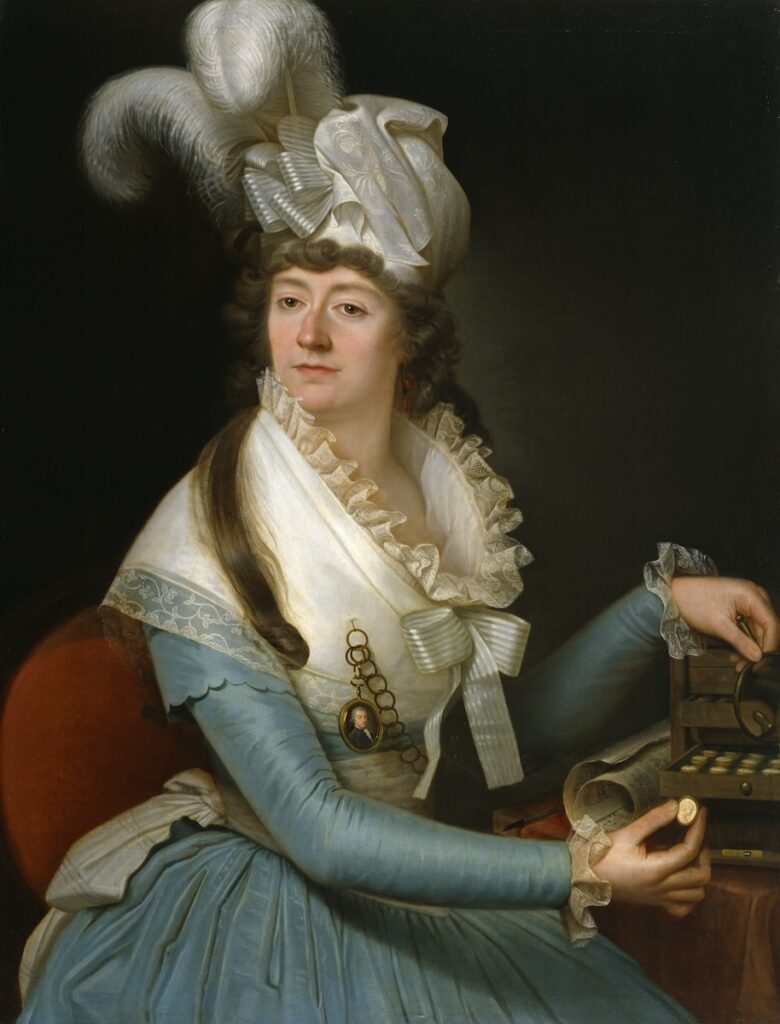
Wedgwood not only reproduced Classical color contrasts in basalt and rosso antico with red and black Greek figures, but he also created jasper cameos with white figures on variously colored grounds that were meant to replicate those from antiquity collected by people with Classical taste (Fig. 5). Additionally, he made jasper plaques of contrasting colors containing portrait busts that celebrated Britons, Europeans, and Americans who contributed to the arts, sciences, business, and politics. In the catalogue Wedgwood published in 1787, the year he produced the antislavery medallion, he offered many jasper cameos, providing advice as to how women and men could incorporate them into objects for their home or person. He also advertised jasper “Heads of Illustrious Moderns” such as Queen Charlotte, Shakespeare, Erasmus, and Benjamin Franklin, and many were available in blue grounds with white busts.[9] Esteemed ancients and moderns thus appear as red, black, and white colored figures in Wedgwood products, signifying the best of British, European, and American civilization through style rather than different complexions. Unlike the enslaved Black man in the antislavery medallion, color for these persons was never linked to their position.
Eighteenth-Century Art and Perceptions of Human Difference
Complexion color contrasts in period art and design had fluid as well as fixed elements, though in each case they reinforced White investment in shared concepts of human excellence. For example, Benjamin West’s 1770 painting The Death of General Wolfe, widely admired when it was exhibited at the Royal Academy in London, features vivid British red coat uniforms offset against Wolfe’s white face leached of blood (Fig. 6). The general’s pale visage also contrasts with that of the copper-colored, partially clothed American Indian warrior with red face paint who respectfully contemplates Wolfe’s noble demise. Red and white juxtapositions in West’s painting accentuate a heroic, patriotic death, and frame cultural difference in terms of attire and complexion.
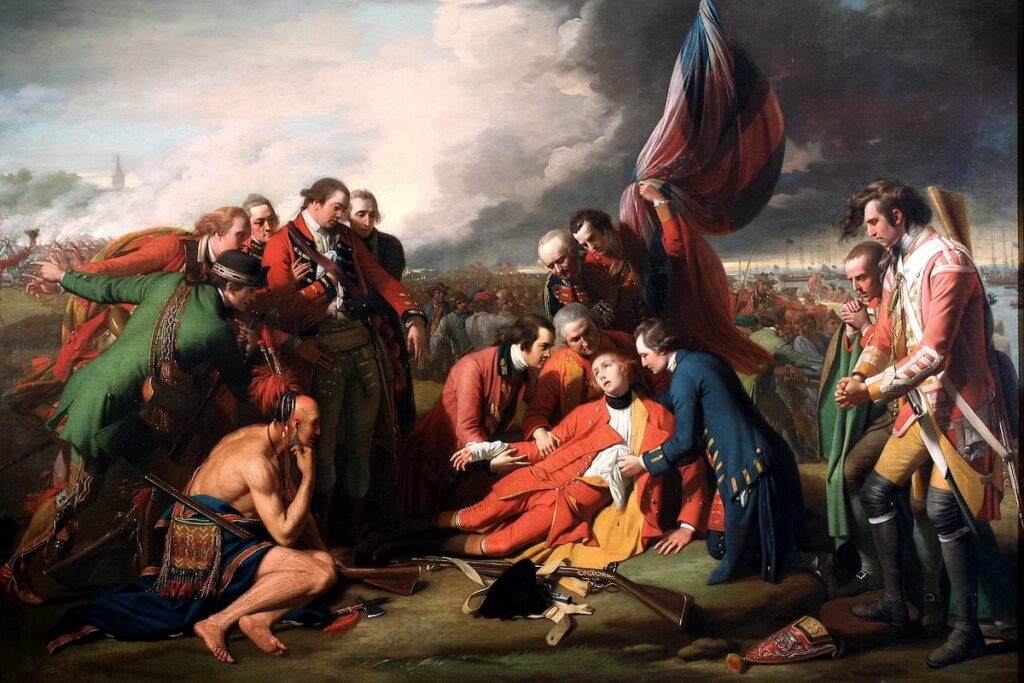
As Roxann Wheeler has argued, skin color was not firmly racialized until the last quarter of the eighteenth century. Instead, Britons demarcated human difference through what they perceived to be virtuous, civilized conduct (Christian and educated) versus savage, uncivilized behavior (pagan and unschooled).[10] Dror Wahrman has shown how deportment rather than fixed skin color operated visually in this context in two West drawings created between 1765-1766 (and subsequently engraved), both of which document exchanges between Indians and colonists. The first, The Indians Giving a Talk to Colonel Bouquet in a conference at a Council Fire Near his Camp on the Banks of Muskingum in America, in October 1764, 1765, represents angry Indians shown visibly darker than Britons (Fig. 7). The second, The Indians Delivering up the English Captives to Colonel Bouquet near his camp at the folks of Muskingum in North America in November 1764, 1765, depicts sorrowful Indians as light skinned as their interlocutors, delivering adopted British captives to their biological family (Fig. 8). Complexion color is thus a mutable marker of enlightened behavior: in West’s representations of Indians in these two prints and in The Death of General Wolfe, dark skin separates Indians from the English only when the former appear savage rather than subservient to British civilization.[11]
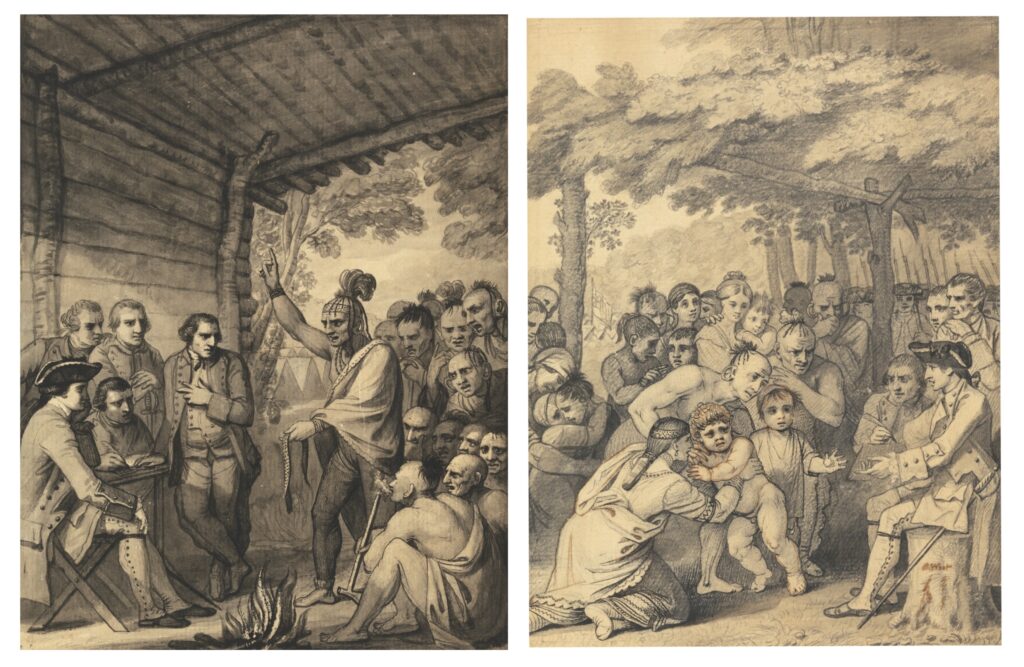
RIGHT: Fig. 8. Benjamin West, The Indians Delivering up the English Captives to Colonel Bouquet near his camp at the folks of Muskingum in North America in November 1764, 1765, created between 1765-1766. Graphite, pen and black ink, and pen and brown ink on beige laid paper, 25.7 x 21 cm. Yale Center for British Art, Paul Mellon Collection. Image courtesy of Yale Center for British Art.
However, as Anne Lafont has demonstrated, relations between enslaved Africans and Europeans were consistently represented by fixed color contrasts. In works such as Pierre Mignard’s 1682 Portrait of Louise De Kéroualle, Duchess of Portsmouth, with an unknown female attendant, Black bodies literally and figuratively prop up White ones: small, enslaved African youths painted black lovingly attend grand, noble European women painted white (Fig. 9). Skin color is not mobile in such imagery. As Lafont observes, the sharp contrast of black and white skin affords aesthetic pleasure while signaling White women’s ownership of their Black servants.[12] In West’s and Mignard’s artworks, freedom and subjugation inform color contrasts used to represent persons. Britons and Europeans who are free to take from and own others are depicted white, as are civilized Indians; Indians uncivilized are shown darker; and enslaved Africans are colored black.
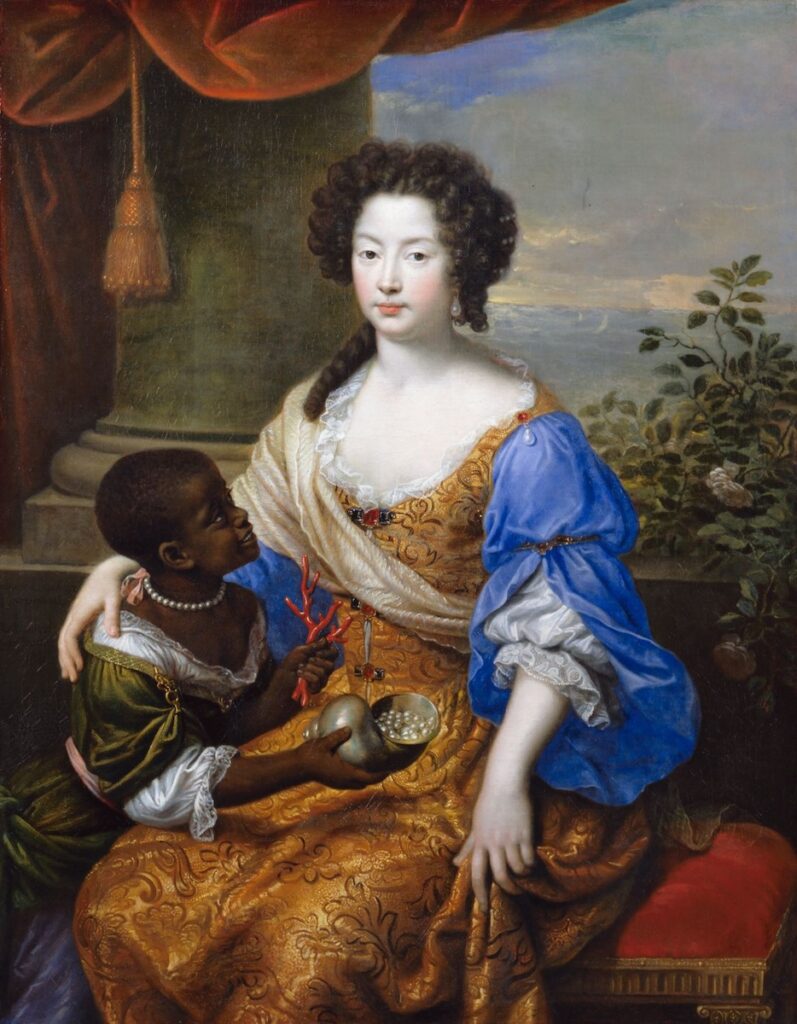
Unaker: White and the Cherokee Ground of the Antislavery Medallion
Just as color as a cultural and racial marker is an important dimension of the antislavery medallion, so too is color as a material substance. As R. Ruthie Dibble and Joseph Zordan have argued in their history of Wedgwood’s and other potters’ use of unaker, this Cherokee white clay was, like colonized American Indian land, a foundation upon which White wealth was built at the expense of Native wealth, land, and kinship.[13] Wedgwood and other potters in Britain and North America experimented with unaker in their quests to produce porcelain and thus break Britain’s dependence on China for the prized ceramic. Wedgwood employed unaker to make bicolor jasperware, his answer to porcelain, and to create paint that colored his Greek figures. He thus utilized the Cherokee clay to build his practice of coloring bodies to suit the fashion for colored contrasts.
In 1767, Wedgwood sent his agent Thomas Griffiths to obtain unaker from Cherokees at Ayoree in North Carolina. Griffiths subsequently produced a report for his employer, now published by William L. Anderson with a detailed history of Wedgwood’s and other potters’ use of the Cherokee clay.[14] Griffiths first met Cherokees in South Carolina, at Andrew Williamson’s plantation White Hall and at Fort Prince George adjacent to the Cherokee town Keowee. Williamson had fought Cherokees as a lieutenant and encouraged his soldiers to keep the Native captives as slaves.[15] He may have enslaved Cherokees at White Hall. While Griffiths visited, Williamson did house a ransomed Cherokee leader’s wife, perhaps the niece of the esteemed diplomat Attakullakulla.[16] Griffiths escorted this important woman to Fort Prince George where Cherokee headmen, including Attakullakulla, were meeting to choose delegates for a New York conference with the Haudenosaunee and the British regarding the boundary line between Indian Country and White settlements. During this critical meeting, the Cherokees’ most important leaders extended great courtesy to Griffiths by feeding him and smoking with him. Griffiths asked for a lot more by requesting unaker, for the substance provided Cherokees with body paint, the means to create structures, and to make ceramics—including pipes with which they formed connections with others such as Griffiths.[17] The agent noted in his report to Wedgwood that the headmen decided to give Griffiths some unaker, with a caveat:
[Since I] behaved like a True Brother, in taking care to conduct their Squaw safe home, they did not care to disappoint me for that time; but if I sho,d want more for future, they must have some satisfaction for they did not know what use that Mountain might be to them, or their Children; and if it would make fine punch Bowls, as they had been told, they hop,d I wo,d let ,em drink out of one; and thus we shoke hands and settled the matter.[18]
The Cherokees’ careful gift was thus based on reciprocity and a guarantee of respect. They honored Griffiths for having returned an important person to them and thus brought him into a familial relationship, language used often in Indian diplomacy.[19] They also expected a gift in turn that would acknowledge how unaker benefited the White men who used it and celebrate the Cherokees’ magnanimity in sharing it. For the Cherokees this was a punchbowl made from unaker, as they understood that the British punchbowl was a ritual item that facilitated conviviality through drink, while often operating also as a tribute to a person or event.[20]
Once in Ayoree, Griffiths was surprised when he was taken prisoner and was told he had to pay “five hundred weight of Leather for every Ton” of unaker.[21] After a lengthy discussion with Cherokees facilitated by a linguist, Wedgwood’s agent reported to the potter that “we settled matters on such conditions as I might obtain what I wanted without any further Molestation…”.[22] Griffiths was visited frequently by Indians while he worked and offered his visitors rum and music. They reciprocated with important gifts: a beloved man (the most revered male in a community) gave Griffiths his best bow and a set of arrows as well as “the old princes pipe.” Griffiths informed Wedgwood that “we continued and parted good friends; but withal, they hoped I sho,d want but a few horse Loads of white clay and pray,d I would not forget the promise I made ,em but perform it so soon as possible.”[23] It is not clear from Griffiths’ report that Wedgwood met the financial terms the Cherokees set, and Wedgwood never produced a punchbowl for any Cherokee headmen. Instead, he used unaker purely for his own purposes: for paint (which he patented in 1769) to decorate his black basalt vases with red Classical figures, and for the creation of jasper, the material he used to make thousands of two-color products including the antislavery medallion.[24]
Wedgwood was never definite about how and for how long he employed unaker in jasper.[25] Mentions of the practic eappear largely in private correspondence—a 1777 letter he wrote to his partner Thomas Bentley stated that all of his jasper to that point included it, and a 1783 missive to William Constable implied he was still using unaker for jasper.[26] The potter’s only interest in publicly representing his use of unaker was to exoticize it as a selling feature of jasper, an advertising scheme he proposed to Bentley in 1777, which Bentley likely rejected.[27] Thus, consumers were not informed that unaker was an ingredient in Wedgwood’s products. Although the Cherokee white earth was firmly embedded within both the paint for Classicizing ware and the clay that produced two-color jasperware, he rendered it invisible.
The Black labor that Griffiths acknowledged in his missive to Wedgwood is another concealed material component of jasper. Griffiths reported paying in Charleston “Coopers and Negroes” for repacking clay and “Negroes” for rolling the clay down to the wharf.[28] These Black men were almost certainly enslaved as Griffiths differentiates them from coopers, whom he does not describe in terms of color, therefore suggesting they were White. Enslaved and free Africans were coopers in Charleston, but Griffiths describes the “Negroes” he employed as packing and rolling unaker in barrels, work less specialized than that of coopers, who made barrels. Enslavers regularly hired out the enslaved, so the pay the Black laborers received would not have been their own.[29] Wedgwood thus acquired unaker from Cherokees who were not paid, and he paid enslavers for the use of men they held as chattel.
Racialized and Universalized Figures and the Antislavery Medallion
Material transactions such as these grounded in Indian land dispossession and slavery, which are hidden but constitutive of the antislavery medallion, are visible in certain literal, black and white signs of colonized labor: period trade signs and cards. These images, which facilitated commerce, regularly employed malleable, racialized representations that reinforced White supremacy.[30] Those that pertain directly to slavery include tobacco advertisements such as that for Roll’s Best Virginia in Whites-Alley, London (Fig. 10). The woodcut features two smoking Indians in the foreground and another in the background holding a parasol over the head of a planter receiving tobacco from an enslaved man. This man and another seem to emerge from barrels, as if they are themselves commodities, while another appears to move one of the containers. This third figure wears a skirt like that of the Indians, who also wear headdresses; another one of the enslaved men holds a hatchet. The Indian’s tobacco plant and smoking ritual, which for Indians facilitate relations human and spiritual, are represented as colonial commodities endorsed by solicitous Indians and produced by enslaved labor.[31] All are colored black except for the planter outlined in black to seem White. Because the enslaved and the colonized share the same color and certain accoutrements, distinctions between Africans and Indians blur but coalesce around subservience to the White colonizer. This points not only to colonizers having enslaved Indians as well as Africans, but also to the conceit that both peoples exist for Whites to enable commercial gain and authoritative stature. In the trade card there is no room for West’s suggestion in The Indians Delivering up the English Captives to Colonel Bouquet that Indians can be white when civilized: just the notion that Indians, like Africans, are dark people subject to White Britons.
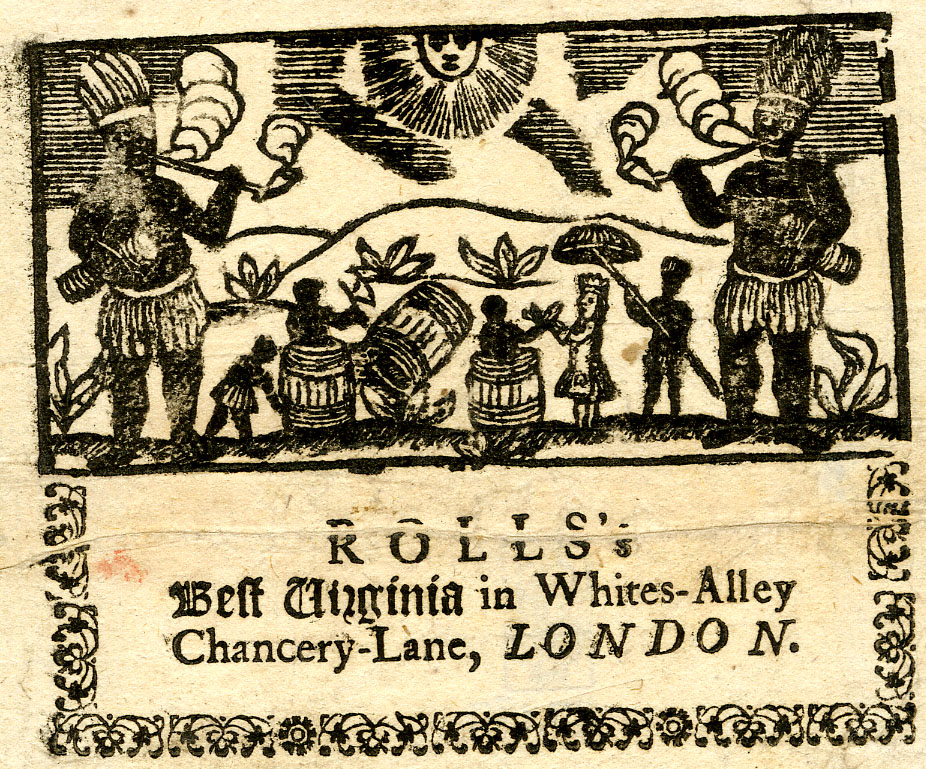
Such a visually crude and conceptually ugly black and white image stands in sharp contrast to Wedgwood’s black and white antislavery medallion. In this medallion, black was Black, for as Thomas Clarkson, a leading abolitionist, maintained, the kneeling figure appeared in “his own native colours.”[32] The medallion was based on a design for a seal produced in 1787 at the behest of the London Committee of the Society for Effecting the Abolition of the Slave Trade, to which Wedgwood belonged.[33] Joseph Woods, Joseph Hooper, and Phillip Sansom were charged with creating the seal and worked with Wedgwood’s chief modeler William Hackwood to do so. Hackwood and Wedgwood made the seal design neoclassical for the medallion: the kneeling black figure on white ground, clearly enslaved due to the chains that bind him, has the standardized, idealized Greco-Roman form that served as the template for human excellence in British, European, and American culture.[34]
The enslaved Black man’s kneeling posture, alongside the figure’s imputed message “AM I NOT A MAN AND A BROTHER?,” compounds associations with the human ideal, through references not only to the Classical world but also to the Christian tradition. The iconography of the kneeling person appears in images of Atlas upholding the heavens, of Hercules, and in countless images of Christians supplicating God. In each case, the figure on bended knee acknowledges through bodily gesture the weight of a force to which it is bound. When that body communicates its own strength through physical substance—as do the muscled forms of Hercules and Wedgwood’s enslaved man—power dynamics can possess nuance. Some writers who analyze the antislavery medallion address this undercurrent, and others observe that the enslaved Black man asserts power through his appeal to shared humanity.[35] However, most commentators argue that this appeal is a sentimental re-inscription of White superiority since the kneeling Black man depends on it to secure his freedom.[36]
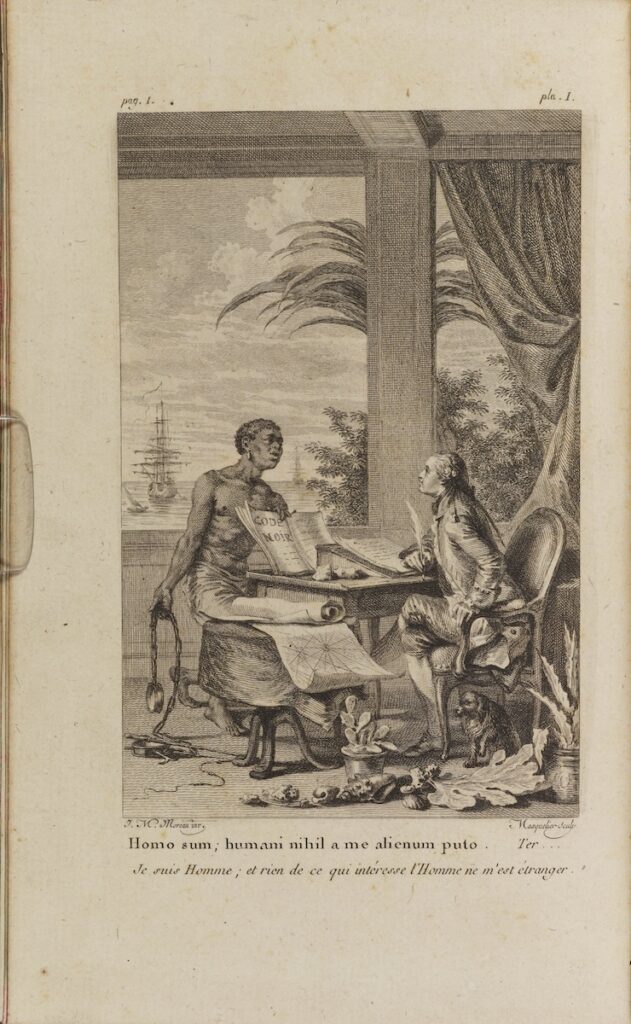
The kneeling enslaved Black man shows up in two neoclassical French prints that precede the medallion, one on paper and the other on toile.[37] The printed images appear in black and white in the first instance, and blue and white and red and white in the second. Color contrasts in both imply differences in complexion and convey hierarchy, while the second is inflected also with patriotism. The earliest is an engraved frontispiece for Bernardin de Saint Pierre’s 1773 antislavery Voyage à l’Île de France (Fig. 11). The black and white print features a kneeling enslaved man colored solidly to seem Black holding chains and the Code Noir before a Frenchman outlined in black to seem White. Like Wedgwood’s medallion, it contains text that asserts human equality across difference, in this instance the ancient Roman poet Terence’s saying: “I am a man and nothing that is human is foreign to me.”
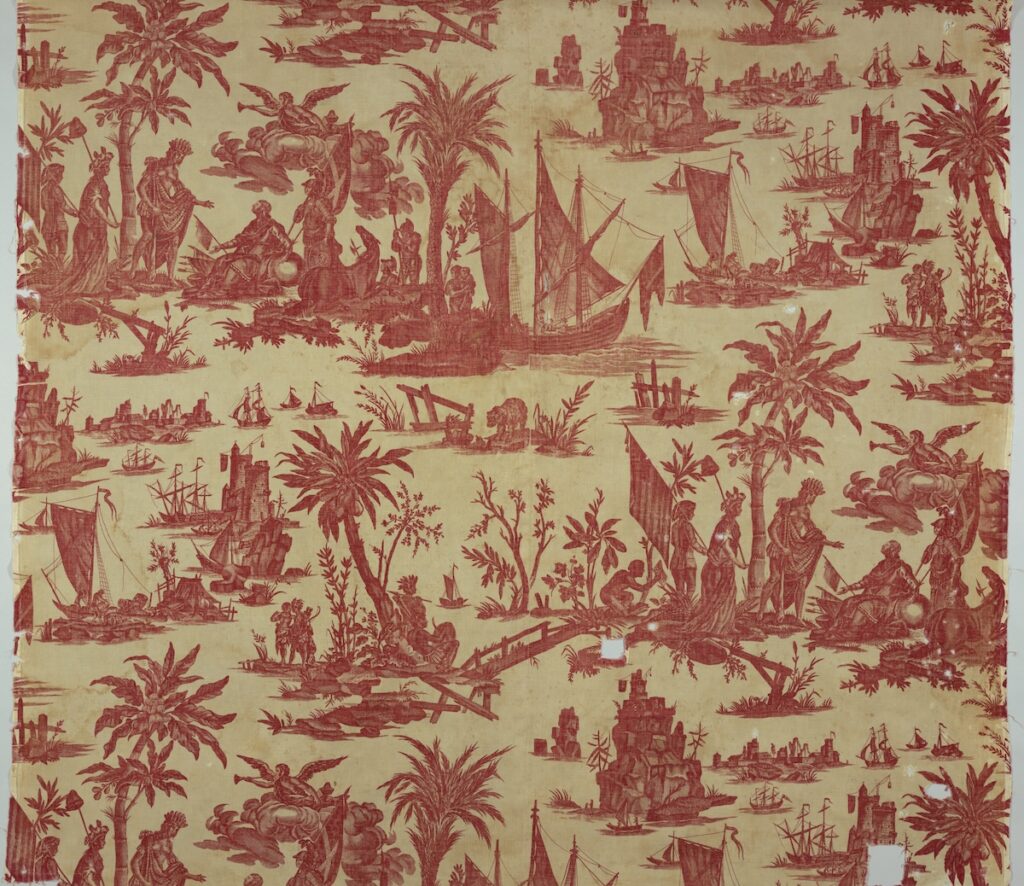
The second French representation of a kneeling enslaved Black man appears as a toile first printed in 1781, in both blue and white and red and white versions, that commemorates the 1778 American Treaty of Alliance with France (Fig. 12). The allegorical image reads left to right, and the personages are neoclassical with Greco-Roman as well as “savage” props.[38] At left, a kneeling enslaved man colored solidly to appear Black offers up a document with a picture of chains. Before him stands a young man outlined in color to appear White wearing a coonskin hat with an enormous American flag on his shoulder. Two female figures precede him: the first a Goddess of Liberty with a Phrygian cap atop a pole; the next and final figure in the group a semi-naked “Princess” rendered white through outline like the goddess, with a feather crown and an alligator underfoot to signify that she is Native.
As with West’s The Indians Delivering up the English Captives to Colonel Bouquet, the Indian complexion is white like the European when the former is as “civilized” as the latter. The enslaved figure, whether blue or red, is resoundingly dark and entreats White figures, male and female, and the Indian female figured white. This composite image reflects Americans’ idealized, terrible conceit that they are strong (like the youth carrying the huge American flag), enlightened (assuredly free like the Goddess of Liberty), and American “natives” (like the Indian “Princess”). In the frontispiece, the enslaved Black man implores a White man; in the toile, an enslaved Black man implores White figures who represent civilization, an allegory made American by the incorporation of a female figure who is supposedly Indian.
The Medallion: Color Contrasts, Embodiment, and Abstraction
The two French representations of a kneeling enslaved Black man demonstrate that such an image—in black, blue, and red—circulated as a critique of slavery before appearing in Wedgwood’s antislavery medallion in those colors as well as white. The medallion differs from the prints due to the enslaved white figure and because the figure is sculpted, thereby possessing an embodied dimension. These elements of color and form complicate the ideas about and experiences of freedom that the medallion elicits.
The object’s relationship to neoclassical cameos meant to be held, collected, worn, or inserted into decorative and useful objects further sets it apart from the printed materials that preceded it. While the printed materials were touched, examined, and displayed, they were not objects that could be fondled, passed hand to hand, placed in collections of other objects, or set into jewelry, fobs, and hair accessories—adornment Clarkson remarked upon as proof of the medallion’s success—all actions that personalized and enhanced the wearer’s cultural capital.[39] The marked color contrasts of the medallions would have stood out against other colors sported, which would have been the case too when the medallions were affixed to containers and display items of all sorts, including snuff boxes that men and women carried. Although the medallions were small, the aesthetic appeal of their prominent contrasts, their links to much admired cameos, and their suitability for decorations that could be put on display aggrandized those that used them. White bodies had the agency to possess and handle the Black body Wedgwood represented—as an index of their commitment to abolitionism—while the actual Black enslaved bodies referenced by the image could not own themselves and were often horrifically abused by their White enslavers.
Wedgwood’s white versus black enslaved figure speaks to other forms of malleability that resonate with White superiority. Wedgwood produced a white figure/blue ground version of his medallion around the time of his 1787 black and white piece and gave a blue and white allotment to Benjamin Franklin for distribution to American abolitionists.[40] Since he did not sell the medallion, his profit was cultural rather than financial.[41] That same year, Franklin himself showed up as a jasper plaque in Wedgwood’s 1787 catalogue and, like the kneeling enslaved man, was represented as a white figure on a blue ground. This color combination was especially rewarding for Wedgwood. His jasper experiments and comments about them suggest that he had great success with blue coloration.[42] For Wedgwood, blue and white was straightforward to produce and appealing to consumers. Blue and white Chinese porcelain and the Euro-American versions of this ceramic were valued prestige items. Blue and white in textiles were colors linked to patriotism, a surging force in the later eighteenth century. The potter’s use of a white rather than black figure for the antislavery medallion is thus calculated to mark fashionable taste: a grotesque move that undercuts Wedgwood’s commitment to abolitionism. It speaks to the logic of style and prestige that defined his business, one that he laid bare in a 1779 letter to Bentley: “Fashion is infinitely superior to merit in many respects, and it is plain from a thousand instances that if you have a favourite child you wish the public to fondle and take notice of, you have only to make choice of proper sponcers [sic]. If you are lucky in them no matter what the brat is, black, brown, or fair, its fortune is made.”[43]
This link between bodies racialized through color and the colored bodies of Wedgwood wares is further underscored in a 1772 Wedgwood missive sent to Bentley, in which he wrote: “Thank you for your discovery in favour of the Black Teapots. I hope white hands will continue in fashion and then we may continue to make Black Teapots.”[44] As Lafont has demonstrated, the aesthetic pleasure of black and white was grounded from the early modern period in contrasts between elite ladies’ white skin and that of the enslaved Black youths they owned and used.[45] That a racialized contrast between other complexions was publicly linked to Wedgwood ware is evident in George Colman Jr.’s popular 1787 play Inkle and Yarico, based on a well-known story widely circulated from 1657. The tale and play center on a biracial couple: an English merchant named Inkle who uses the Amerindian Princess Yarico for personal gain. Inkle’s servant Trudge describes Yarico in these terms: “She’s a good comely copper…. quite dark; but very elegant, like a Wedgwood teapot.”[46] In this instance, the color contrast suggests that the Native woman is a commodity as valuable as those Wedgwood produced, a copper-red object in service to the White hands and person of her businessman husband.
This description indicates that Wedgwood’s rosso antico, though on its face a Classical reference, was also linked to Native “red” bodies and to coalescing ideas of race. The Indian, and colored human and clay bodies, also amalgamate in the Wedgwood jasper red figure/black ground antislavery medallion that was likely first produced around the beginning of the nineteenth century (see Fig. 3).[47] Another example of the potter’s neoclassical taste for the red and black contrasts of Greek vase painting, and another abstraction of color from the Black enslaved man in Wedgwood’s medallion, the piece inadvertently and perversely points to Indian bodies enslaved alongside Black, both harnessed for the White project of colonization as supposed civilization. The irony of abolitionism attached to this dynamic squares with Wedgwood’s reckoning that his colored products, his “brats,” had to fit the fashion of their “sponcers,” to make their—his—“fortune.” Those “fair” enslaved figures of the antislavery medallion are particularly terrible in this context. Part of the period fashion for colored contrasts that often presented racialized others, whether cast black or red, as subservient to Whites, they show that the contrasting colors of the object most associated with eighteenth-century abolitionism speak more to White freedom of fashion than true compassion for the Black experience of slavery.
Andrea Feeser is Professor of Art History at Clemson University, built on Fort Hill and Hopewell plantations and Cherokee Homelands
Acknowledgments: I dedicate this text to my mother, who passed away while I was writing this article.
[1] Iris Moon, Melancholy Wedgwood (Cambridge, MA: MIT Press, 2024), 16.
[2] When writing of Native peoples, I use terminology recommended by Robert Warrior, Hall Distinguished Professor of American Literature and Culture at the University of Kansas and a member/citizen of the Osage Nation. First, I employ “the names that specific tribal groups have for themselves … or at least the names by which they have come to be known since the European colonization of the Americas,” and then American Indian as a noun with Indian and Native as adjectives.” Robert Warrior, “Indian,” in Keywords for American Cultural Studies, ed. Bruce Burgett and Glen Hendler (New York: New York University Press, 2014), https://keywords.nyupress.org/american-cultural-studies/essay/indian/ (all urls, unless otherwise indicated, accessed January 5, 2024).
[3] Cary Carson, “Why Demand?,” in Face Value: The Consumer Revolution and the Colonizing of America (Charlottesville: University of Virginia Press, 2017), 15-37.
[4] Leslie Warwick and Peter Warwick, “New Perspectives on Chinese Export Blue-and-White Canton Porcelain,” Chipstone Foundation, https://chipstone.org/article.php/519/Ceramics-in-America-2012/New-Perspectives-on-Chinese-Export-Blue-and-White-Canton-Porcelain; “Chinese blue-and-white ceramics,” Victoria and Albert Museum, https://www.vam.ac.uk/articles/chinese-blue-and-white-ceramics.
[5] Sarah Lowengard, “Sources, Materials, Techniques,” The Creation of Color in Eighteenth-Century Europe, http://www.gutenberg-e.org/lowengard/B_Chap03.html.
[6] Sarah Lowengard, “Parameters of Color Quality,” The Creation of Color in Eighteenth-Century Europe, http://www.gutenberg-e.org/lowengard/B_Chap01.html; Susan Fairlie, “Dyestuffs in the Eighteenth Century,” The Economic History Review 17, no. 3 (1965): 488-510.
[7] Michel Pastoureau, Blue: The History of a Color (Princeton: Princeton University Press, 2001), 123.
[8] Gordon Campbell, “Rosso antico,” Grove Art Online, 22 Jan. 2014, https://doi.org/10.1093/gao/9781884446054.article.T2073735.
[9] Josiah Wedgwood, Catalog of cameos, intaglios, medals, bas-reliefs, busts and small statues (New York: Wedgwood Society of New York, 1787), 51.
[10] Roxann Wheeler, Complexion of Race: Categories of Difference in Eighteenth-Century British Culture (Philadelphia: University of Pennsylvania Press, 2000), 7, 35, and passim.
[11] Dror Wahrman, “Climate, Civilization, and Complexion: Varieties of Race,” in The Making of the Modern Self: Identity and Culture in Eighteenth-Century England (New Haven: Yale University Press, 2004), 83-7.
[12] Anne Lafont, “How Skin Color Became a Racial Marker: Art Historical Perspectives on Race,” Eighteenth-Century Studies 51, no. 1 (Fall 2017): 92-3.
[13] R. Ruthie Dibble and Joseph Mizhakii Zordan, “Cherokee Unaker, British Ceramics, and Productions of Whiteness in Eighteenth-Century Atlantic Worlds,” British Art Studies, Issue 21, https://britishartstudies.ac.uk/issues/issue-index/issue-21/british-ceramics-and-productions-of-whiteness.
[14] William L. Anderson, “Cherokee Clay, from Duché to Wedgwood: The Journal of Thomas Griffiths, 1767–1768,” North Carolina Historical Review 63, no. 4 (October 1986): 477-510.
[15] Llewellyn M. Toulmin, “Brig. Gen. Andrew Williamson: The ‘Benedict Arnold of South Carolina’ and America’s First Major Double Agent – Part I,” Journal of Backcountry Studies 2 (2012): 20.
[16] Anderson, “Cherokee Clay,” 501.
[17] Eighteenth-century Cherokees not only used white unaker but also red clay for body decoration, rituals, built structures, and utilitarian items including pipes and pots (John Lawson, A New Voyage to Carolina [London, 1709], 192 and 208; James Adair, Adair’s History of the American Indians, edited by Samuel Cole Williams [New York: Promontory Press, 1973], 167 and 413; “clay” in Henry Timberlake, The Memoirs of Lieut. Henry Timberlake (Who Accompanied the Three Cherokee Indians to England in the Year 1762) [London, 1765; Project Gutenberg, 2021], https://www.gutenberg.org/cache/epub/65256/pg65256-images.html; James Mooney, The Sacred Formulas of the Cherokees Seventh Annual Report of the Bureau of Ethnology to the Secretary of the Smithsonian Institution, 1885-1886 [Washington, 1891]; Project Gutenberg, 2008, https://www.gutenberg.org/cache/epub/24788/pg24788-images.html; Barbara Duncan, Brett H. Riggs, Christopher B. Rodning, and Mickel Yantz, Cherokee Pottery: People of One Fire [Tahlequah, OK: Cherokee Heritage Press, 2007]; Christopher B. Rodning, Center Places and Cherokee Towns: Archaeological Perspectives on Native American Architecture and Landscape in the Southern Appalachians [Tuscaloosa: University of Alabama Press, 2015], 21).
[18] Anderson, “Cherokee Clay,” 503.
[19] Jane T. Merritt, “Metaphor, Meaning, and Misunderstanding: Language and Power on the Pennsylvania Frontier,” in Contact Points: American Frontiers from the Mohawk Valley to the Mississippi, 1750-1830, edited by Andrew Cayton and Fredrika J. Teute (Chapel Hill: Omohundro Institute of Early American History and Culture and University of North Carolina Press, 1998), 74.
[20] Karen Harvey, “Ritual Encounters: Punch Parties and Masculinity in the Eighteenth Century,” Past and Present 214, no. 1 (2012): 165-203.
[21] Anderson, “Cherokee Clay,” 506. Anderson states in n. 134 of his article that this amount of leather was the same normally offered by White leaders to Indians to prevent the latter from a revenge killing after a White person murdered an Indian.
[22] Anderson, “Cherokee Clay,” 506.
[23] Anderson, “Cherokee Clay,” 506.
[24] Eliza Meteyard, The Life of Josiah Wedgwood from His Private Correspondence and Family Papers in the Possession of Joseph Mayer (London: Hurst & Blackett, 1866), 80.
[25] Dibble and Zordan, “Cherokee Unaker.”
[26] Anderson, “Cherokee Clay,” 497.
[27] Dibble and Zordan, in “Cherokee Unaker,” cite Robin Reilly as the scholar who suggested that Bentley likely rejected the advertising strategy (Robin Reilly, Wedgwood Jasper [London: Thames & Hudson, 1994], 89-90).
[28] Anderson, “Cherokee Clay,” 509.
[29] For enslaved men and women hired out by masters and by themselves, see Philip D. Morgan, Slave Counterpoint: Black Culture in the Eighteenth-Century Chesapeake and Lowcountry (Chapel Hill: Omohundro Institute of Early American History and Culture, 1998), 350-3.
[30] David Bindman, Paul Kaplan, and Helen Weston, “The City Between Fantasy and Reality,” in The Image of the Black in Western Art from the “Age of Discovery” to the Age of Abolition—The Eighteenth Century, edited by David Bindman and Henry Louis Gates, Jr. (Cambridge, MA: Harvard University Press, 2011),196-7.
[31] Virginia Drywater-Whitekiller describes an instance of this in Cherokee experience, in “Bringing Back the Tobacco,” Cultural Survival, Living in Two Worlds 35, no. 3 (September 13, 2011): https://www.culturalsurvival.org/publications/cultural-survival-quarterly/bringing-back-tobacco.
[32] Quoted in Hunt, The Radical Potter, 228.
[33] Martha Katz-Hyman maintains that sources for the medallion are unknown, but notes that one may have been the sketch of a kneeling, enslaved African man colored black from the 1783 minutes of the London-based Quaker Society of Friends yearly meeting (“Doing Good While Doing Well: The Decision to Manufacture Products that Supported the Abolition of the Slave Trade and Slavery in Great Britain, Slavery and Abolition 29, no. 2 [June 2008]: 220, 226, n. 3).
[34] Cheryl Finley, Committed to Memory: The Art of the Slave Ship Icon (Princeton: Princeton University Press, 2018), 52.
[35] Cynthia S. Hamilton, “Hercules Subdued: The Visual Rhetoric of the Kneeling Slave,” Slavery & Abolition 34, no. 4 (2013): 631–52.
[36] Mary Guyatt, “The Wedgwood Slave Medallion: Values in Eighteenth-Century Design,” Journal of Design History 13, no. 2 (2000): 93–105.
[37] For the frontispiece see Mary L. Bellhouse, “Candide Shoots the Monkey Lovers: Representing Black Men in Eighteenth-Century French Visual Culture,” Political Theory 34, no. 6 (December 2006): 741-84; for the toile see Aziza Gril-Mariotte, “Topical Themes from the Oberkampf Textile Manufactory, Jouy-en-Josas, France, 1760-1821,” trans. Pamela J. Warner, Studies in the Decorative Arts 17 (2009): 162-97.
[38] Freyda Spira, “Allegories of the Four Continents,” (March 2021), Heilbrunn Timeline of Art History (New York: The Metropolitan Museum of Art, 2000–) https://www.metmuseum.org/toah/hd/alfc/hd_alfc.htm.
[39] Guyatt, “The Wedgwood Slave Medallion,” 97.
[40] Object Record, Wedgwood Anti-Slavery Medallion, American Philosophical Library Museum, accessed July 31, 2023, https://amphilsoc.pastperfectonline.com/webobject/E3568868-3223-4FCE-8236-053981986784.
[41] Guyatt, “The Wedgwood Slave Medallion,” 97.
[42] Hunt, The Radical Potter, 160-1.
[43] Hunt, The Radical Potter, 89.
[44] Diana Edwards, Black Basalt: Wedgwood and Contemporary Manufacturers (Woodbridge, Suffolk: Antique Collectors’ Club, 1994), 60. See also Patricia A. Mathew, “‘I hope White Hands’ – Wedgwood, Abolition, and the Female Consumer,” filmed March 3, 2021 for the Jane Austen Summer Program “Race and the Regency,” https://www.youtube.com/watch?v=VBtXTWotXbY (accessed August 2, 2023).
[45] Lafont, “How Skin Color Became a Racial Marker,” 92-3.
[46] Nandini Bhattacharya, “Family Jewels: George Colman’s ‘Inkle and Yarico’ and Connoisseurship,” Eighteenth-Century Studies 34, no. 2 (Winter 2001): 208.
[47] The Brooklyn Museum medallion is a rare color combination and is dated by the museum to after 1786. The large Wedgwood collection at the V&A holds similar basalt pieces with applied red design that date to the early nineteenth century. See V&A Collections, Wedgwood, black basalt, https://collections.vam.ac.uk/search/?q=Wedgwood&images_exist=true&page=6&page_size=50&id_material=x30176 (accessed July 31, 2023).
Cite this article as: Andrea Feeser, “When Blue and White Obscure Black and Red: Conditions of Wedgwood’s 1787 Antislavery Medallion,” Journal18, Issue 17 Color (Spring 2024), https://www.journal18.org/7244.
Licence: CC BY-NC
Journal18 is published under a Creative Commons CC BY-NC International 4.0 license. Use of any content published in Journal18 must be for non-commercial purposes and appropriate credit must be given to the author of the content. Details for appropriate citation appear above.
